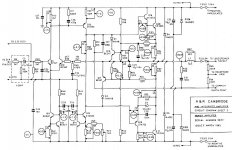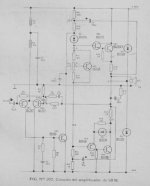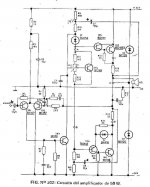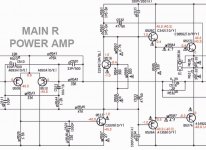R51/C27 is compensation for the VAS transistor Q13.
Every time I look at that schematic, looking at R50 makes me shudder
Every time I look at that schematic, looking at R50 makes me shudder

Hi,
regarding c30 it look like that it's a simple compensation cap..........but the its function is more complex:
Arcam c60 has a quasi-complementary final stage because it uses
a npn bjt Q21 (a very slow 2n3055) instead of a pnp.
Mr. Curtis (the designer), for giving a functionality near to a fully-complementary design, has put D3 in the schematics.
Q19 , D3 and the 82 ohm resistor near it should recreate (in theory...) the Q20 and q16 series Vbe non-linearity.
The q20 and q16 darlintong has the q20 velocity (velocity ? ........
velocity is a big word for an 2n3055 !) , the complementary pair for the negative side has the velocity (hem....slowing) of Q21 (an other 2n3055).
When Q21 is on C30 isn't necessary (but helps.......) because the velocity near to the darlintong is given by D3, but when Q21 is off (for positive output voltages) C30 is very important because , in this case, D3 is off (the D3's current is complemetary to q20 base junction current.........) and C30 gives a velocity to the reopen Q21 near to Q20 velocity.
Kind regards,
ppa
PS: Hi guys ! I have some old 2n3055 , I give you for free...............(only shipping cost).........I joke.........I have just given they to my friend......................................................................................................................................................................................................................................................................................................................................................................................................for free!
regarding c30 it look like that it's a simple compensation cap..........but the its function is more complex:
Arcam c60 has a quasi-complementary final stage because it uses
a npn bjt Q21 (a very slow 2n3055) instead of a pnp.
Mr. Curtis (the designer), for giving a functionality near to a fully-complementary design, has put D3 in the schematics.
Q19 , D3 and the 82 ohm resistor near it should recreate (in theory...) the Q20 and q16 series Vbe non-linearity.
The q20 and q16 darlintong has the q20 velocity (velocity ? ........
velocity is a big word for an 2n3055 !) , the complementary pair for the negative side has the velocity (hem....slowing) of Q21 (an other 2n3055).
When Q21 is on C30 isn't necessary (but helps.......) because the velocity near to the darlintong is given by D3, but when Q21 is off (for positive output voltages) C30 is very important because , in this case, D3 is off (the D3's current is complemetary to q20 base junction current.........) and C30 gives a velocity to the reopen Q21 near to Q20 velocity.
Kind regards,
ppa
PS: Hi guys ! I have some old 2n3055 , I give you for free...............(only shipping cost).........I joke.........I have just given they to my friend......................................................................................................................................................................................................................................................................................................................................................................................................for free!
Hi,
I repeat with correct typing
regarding c30 it look like that it's a simple compensation cap..........but the its function is more complex:
Arcam c60 has a quasi-complementary final stage because it uses
a npn bjt Q21 (a very slow 2n3055) instead of a pnp.
Mr. Curtis (the designer), for giving a functionality near to a
fully-complementary design, has put D3 in the schematics.
Q19 , D3 and the 82 ohm resistor near it should recreate
(in theory...) the Q20 and q16 series Vbe non-linearity.
The q20 and q16 darlintong has the q20 velocity (velocity ? ......
velocity is a big word for an 2n3055 !) , the complementary pair for the negative side has the velocity (hem....slowing) of Q21 (an
other 2n3055).
When Q21 is on C30 isn't necessary (but helps.......) because the
velocity near to the darlintong is given by D3, but when Q21 is off
(for positive output voltages) C30 is very important because , in
this case, D3 is off (the D3's current is complemetary to q20 base junction current.........) and C30 gives a velocity to the reopen
Q21 near to Q20 velocity.
Kind regards,
ppa
PS: Hi guys ! I have some old 2n3055 , I give you for free...............(only shipping cost).........I joke.........I have just
given they to a my
friend.................for free!
I repeat with correct typing
regarding c30 it look like that it's a simple compensation cap..........but the its function is more complex:
Arcam c60 has a quasi-complementary final stage because it uses
a npn bjt Q21 (a very slow 2n3055) instead of a pnp.
Mr. Curtis (the designer), for giving a functionality near to a
fully-complementary design, has put D3 in the schematics.
Q19 , D3 and the 82 ohm resistor near it should recreate
(in theory...) the Q20 and q16 series Vbe non-linearity.
The q20 and q16 darlintong has the q20 velocity (velocity ? ......
velocity is a big word for an 2n3055 !) , the complementary pair for the negative side has the velocity (hem....slowing) of Q21 (an
other 2n3055).
When Q21 is on C30 isn't necessary (but helps.......) because the
velocity near to the darlintong is given by D3, but when Q21 is off
(for positive output voltages) C30 is very important because , in
this case, D3 is off (the D3's current is complemetary to q20 base junction current.........) and C30 gives a velocity to the reopen
Q21 near to Q20 velocity.
Kind regards,
ppa
PS: Hi guys ! I have some old 2n3055 , I give you for free...............(only shipping cost).........I joke.........I have just
given they to a my
friend.................for free!
don't thank me,
I think that arcam a60 It's a good way for using two 2n3055.
If you want I can council you some modification for it.
Cheer,
ppa
I think that arcam a60 It's a good way for using two 2n3055.
If you want I can council you some modification for it.
Cheer,
ppa
hi all i have one or two points to make about the A60.
1 jaycee. Every time i look at R50 i shudder.[ WHY ] the resistor keeps the base.s of the drivers 2.1 volts apart.
And as the A60 was designed in 1976 and proven to very reliable
Why shudder.
2 To the best of my knowledge john dawson and chris evans
designed the A60.
jim
1 jaycee. Every time i look at R50 i shudder.[ WHY ] the resistor keeps the base.s of the drivers 2.1 volts apart.
And as the A60 was designed in 1976 and proven to very reliable
Why shudder.
2 To the best of my knowledge john dawson and chris evans
designed the A60.
jim
Hi big jim.
Driver original and real in my amplifier BD139-140.
Output original BD183. In my amplifier 2N3055.
My idea is to use MJ15003.
Guillermo
Driver original and real in my amplifier BD139-140.
Output original BD183. In my amplifier 2N3055.
My idea is to use MJ15003.
Guillermo
Hi all,
It's a good idea, but I council you the mj15024 and mje243/2 for the drivers.
you could add the a60's c30 in your amp schematic in the same a60 position.
Could you send us your amp's schematic with more hight resolution ?, because I don't see it very well, please.
Jim, you is right , Mr. Curtis has not designed the arcam A60.
cheer
Pier Paolo
It's a good idea, but I council you the mj15024 and mje243/2 for the drivers.
you could add the a60's c30 in your amp schematic in the same a60 position.
Could you send us your amp's schematic with more hight resolution ?, because I don't see it very well, please.
Jim, you is right , Mr. Curtis has not designed the arcam A60.
cheer
Pier Paolo
big jim said:hi all i have one or two points to make about the A60.
1 jaycee. Every time i look at R50 i shudder.[ WHY ] the resistor keeps the base.s of the drivers 2.1 volts apart.
And as the A60 was designed in 1976 and proven to very reliable
Why shudder.
How is thermal compensation done? It seems to me that it isn't. Even in 1976, a single BC546 and two resistors to form a proper VBE multiplier can't have been that expensive. Even some power diodes mounted on the heatsink is better than relying on the current through this resistor to remain stable.
It is however remarkable that these amps have lasted as long as they have. I can't be too critical of Arcam.. I like a lot of their stuff 🙂
Hi all,
the thermal compensation system isn't the 220 ohm resistance R50 only but there is a transistor (Q14) that is the thermal regolator.
regards
Pier Paolo
the thermal compensation system isn't the 220 ohm resistance R50 only but there is a transistor (Q14) that is the thermal regolator.
regards
Pier Paolo
I have make some english errors, I repeat:
the resistance current depends by this transitor Vbe only.
regards
Pier Paolo
PS: I have made a amplifier with a smilar system , I have used a triple darlintong , but , like I have supposed, the amplifier gone well , without any problems, and the sound it was fine.
the resistance current depends by this transitor Vbe only.
regards
Pier Paolo
PS: I have made a amplifier with a smilar system , I have used a triple darlintong , but , like I have supposed, the amplifier gone well , without any problems, and the sound it was fine.
- Status
- Not open for further replies.
- Home
- Amplifiers
- Solid State
- Arcam A60



